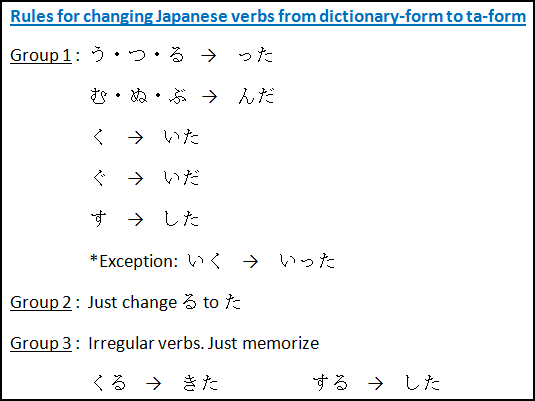- Home
- Basic Lessons
- Japanese Past Tense in Plain Form
Japanese Past Tense in Plain Form -
Free Japanese Lessons: 26
In this lesson, you will get to learn Japanese past tense in plain style. In lesson 17, past tense of Japanese in Polite style has already been introduced.
You have also learned that Japanese can be divided into 2 types of speech - Polite and Plain styles (or forms) in lesson 18 - Japanese verbs.
Polite style is used when you are talking to:
- someone who you met for the first time.
- your superiors, boss, or customers, etc.
- someone who are not very close to you.
On the other hand, Plain style or Casual style is used when you are talking to your family members or someone who are very close to you.
You have gone through and learned many Japanese expressions in the lessons so far and most of them are using Polite style.
However, it's important for you to know how to use Plain style in order to make complicated Japanese sentences.
Japanese Past Tense for Verbs in Plain Form
Referring to the following table you have learned before in lesson 18, you have た-form (ta-form) and なかった-form (nakatta-form) for Japanese Past tense for verbs in Plain form.
た-form (ta-form) is also known as the Past affirmative of Plain form and なかった-form (nakatta-form) is also known as the Past negative of Plain form for Japanese verbs.
| Polite Style | Plain Style | |
| Present Affirmative | ます | じしょ-form or dictionary-form |
| Present Negative | ません | ない-form or nai-form |
| Past Affirmative | ました | た-form or ta-form |
| Past Negative | ませんでした | なかった-form or nakatta-form |
So how can you make Japanese past tense ta-form and nakatta-form? You can make ta-form from dictionary-form the same way you make Japanese verbs te-form.
All you have to do is to replace て (te) with た (ta). For nakatta-form, you can derive it from nai-form of Japanese verbs.
How to Make Japanese Verbs た-form (ta-form)?
Group 1 Verbs
For group 1 verbs which end up with the words う (u), つ (tsu) or る (ru), replace these words with った (tta). For those verbs which end up with the words む (mu), ぬ (nu) or ぶ (bu), replace the words with んだ (nda).
For group 1 verbs which end up with the word く (ku), change the word to いた (ita). For those which end up with the word ぐ (gu), change it to いだ (ida). And for those which end up with the word す (su), change it to した (shita).
However, there is one exception. For the Japanese verb いく (iku) which means "to go", the ta-form is いった (itta).
Group 2 Verbs
Group 2 verbs always end with the word る (ru), you just need to replace る (ru) with た (ta).
Group 3 Verbs
For group 3 verbs, the ta-form of する (suru) is した (shita) and the ta-form of くる (kuru) is きた (kita).
The following diagram shows the summary of how to change from dictionary-form to ta-form for Japanese verbs.

How to Make Japanese Verbs なかった-form (nakatta-form)?
Follow all the rules in lesson 19 on how to change dictionary-form to nai-form. After that, replace ない (nai) with なかった (nakatta) and you will get the nakatta-form for Japanese verbs.
Let's see some examples of changing Japanese verbs from dictionary-form to ta-form, nai-form and nakatta-form.
Group 1 Verbs
| dict-form | Meaning | ta-form | nai-form | nakatta-form | |
| 1. | ある | Exist (Thing) | あった | ない | なかった |
| 2. | かかる | Hang/Take | かかった | かからない | かからなかった |
| 3. | よむ | Read | よんだ | よまない | よまなかった |
| 4. | きく | Listen/Ask | きいた | きかない | きかなかった |
| 5. | あそぶ | Play | あそんだ | あそばない | あそばなかった |
| 6. | かう | Buy | かった | かわない | かわなかった |
| 7. | かえる | Go Back | かえった | かえらない | かえらなかった |
| 8. | のる | Get On/Ride | のった | のらない | のらなかった |
Group 2 Verbs
| dict-form | Meaning | ta-form | nai-form | nakatta-form | |
| 1. | いる | Exist (Human /Animal) |
いた | いない | いなかった |
| 2. | たべる | Eat | たべた | たべない | たべなかった |
| 3. | みる | See | みた | みない | みなかった |
| 4. | でる | Appear/Leave | でた | でない | でなかった |
| 5. | あげる | Give/Offer/ Raise |
あげた | あげない | あげなかった |
| 6. | くれる | Be Given/Let One Have | くれた | くれない | くれなかった |
Group 3 Verbs
| dict-form | Meaning | ta-form | nai-form | nakatta-form | |
| 1. | くる | Come/Arrive | きた | こない | こなかった |
| 2. | する | Do/Execute/ Play |
した | しない | しなかった |
| 3. | べんきょうする | Study | べんきょうした | べんきょうしない | べんきょうしなかった |
| 4. | さんぽする | Walk/Stroll | さんぽした | さんぽしない | さんぽしなかった |
Japanese Past Tense for Nouns in Plain Form
Again, Japanese past tense for nouns in Plain form is quite straight forward. You just need to append different suffixes to the noun as you can see in the following expressions...
| Present Affirmative: | Noun だ |
| Present Negative: | Noun ではない |
| Past Affirmative: | Noun だった |
| Past Negative: | Noun ではなかった |
Using noun あめ (ame - rain) as an example:
- あめ だ (ame da)
- あめ ではない (ame dewanai)
- あめ だった (ame datta)
- あめ ではなかった (ame dewanakatta)
Past Tense for na-Adjectives in Plain Form
Japanese past tense for na-adjectives is exactly the same as that for Japanese nouns. Therefore you can simply use the same expressions as the following...
| Present Affirmative: | な-Adjective だ |
| Present Negative: | な-Adjective ではない |
| Past Affirmative: | な-Adjective だった |
| Past Negative: | な-Adjective ではなかった |
Using na-adjective しずか (shizuka - quiet) as an example:
- しずか だ (shizuka da)
- しずか ではない (shizuka dewanai)
- しずか だった (shizuka datta)
- しずか ではなかった (shizuka dewanakatta)
Past Tense for i-Adjectives in Plain Form
Japanese past tense for i-adjectives needs some modifications to the suffixes. For past affirmative form, remove the い (i) in the い-adjective and replace it with かった (katta).
For past negative form, remove the い (i) in the い-adjective and replace it with くなかった (kunakatta).
As for the Plain form for present affirmative and present negative, remove the です (desu) which originally present in Polite style. Check with the following expressions...
| Present Affirmative: | い-Adjective {~い} |
| Present Negative: | い-Adjective {~ |
| Past Affirmative: | い-Adjective {~ |
| Past Negative: | い-Adjective {~ |
Using i-adjective ながい (nagai - long) as an example:
- ながい (nagai)
- なが くない (nagakunai)
- なが かった (nagakatta)
- なが くなかった (nagakunakatta)
You may feel very confusing with so many different forms for Japanese past tense. Give yourself some time to remember the rules and I am sure you will get the hang of it in no time.
Related Pages
Lesson 17: Past Tense of Japanese in Polite style.
Lesson 18: Japanese Verbs.
Lesson 19: Japanese Verbs Part 2 - Change dictionary-form to masu-form and nai-form.
Lesson 21: Japanese Verbs te-form.
Ready Set Speak Sale! Get up 40% OFF Forever Discount on Premium or Premium PLUS plan! Ends on 19 April 2024
The link above is an affiliate link, which means that I would earn a commission (at no extra cost to you) if you do end up purchasing the related learning course.
Previous - Lesson 25: Japanese Adverbs
Buy me a coffee








Facebook Comments
Don’t see the comments box? Log in to your Facebook account, give Facebook consent, then return to this page and refresh it.